How fast the tide in Hawaii changes, including among airlines. Beat of Hawaii commenter Guy said, “Well the ‘Predator’ (Southwest) kinda, sorta, almost took out the little guy (Hawaiian) but now he is back with his Eskimo cousin (Alaska) and they mean business. The predator is too busy trying to figure out who is in charge, what they want to be and where they are going.”


Southwest’s own depiction and imagery about entering Hawaii was that of it being a predator shark. The company previously used an image of Southwest as a shark eating Hawaiian in their offices.
This comes as Southwest Airlines just reported record revenue of nearly $7 billion but faces mounting financial pressures, including rising operational costs, delays in new aircraft deliveries and more. Amid their challenges—and with activist investor Elliott Management gaining influence on the board—Southwest announced some changes for Hawaii starting next year.
Southwest plans to reduce its some flights in 2025.
Southwest said that this shift will see a focus on more profitable mainland routes and Hawaii redeye flights, signaling what will certainly become a major re-calibration of their Hawaii service model to align with new cost-saving strategies.
They said at the same time they announced a reduction in interisland flights, that Hawaii revenue is growing at a healthy rate, both on inter-island routes and between Hawaii and the mainland. Southwest’s stock has been down modestly since the latest announcements.
Airlines in Hawaii are lifelines for visitors and residents, ensuring essential connections.
Yet in recent years, carriers including Hawaiian and Southwest have encountered growing turbulence. Financial losses, operational inefficiencies, and intense competition have driven the industry into a crisis point. Hawaiian had to be acquired by Alaska Airlines to avoid financial collapse with billions in lumbering debt. Even Southwest, once seen by many as the industry’s heroic, behemoth disruptor, now finds itself spiraling from its shark-like entry into mere survival mode in Hawaii. This raises the pressing question: what major changes are needed to ensure that airlines can sustainably continue to serve Hawaii’s unique market?


The financial strain on airlines, even for Southwest.
Operating flights in Hawaii comes with steep costs. Airlines of course face high fuel prices, significant labor expenses, and the need for continuous aircraft maintenance. These challenges are exacerbated by Hawaii’s geographical isolation and short travel distances between the islands.
Southwest’s entry into Hawaii initially promised a low-cost alternative, but the airline quickly encountered its own operational challenges. For example, using their 175-seat Boeing 737s on interisland routes has often proven too large for demand, compared to Hawaiian’s 128-seat interisland aircraft. This mismatch between aircraft size and route demand adds to the strain on Southwest’s bottom line, and highlights a significant difference in operational strategies both interisland and from the mainland.
Hawaiian Airlines has also faced insurmountable financial difficulties, narrowly avoiding near-certain bankruptcy through its own acquisition by Alaska Airlines. This also raises questions about how the Hawaiian fleet strategy will evolve to continue to meet Hawaii’s unique market needs profitably. Hawaiian for now operates a quarter-century-old fleet of Boeing 717 aircraft interisland, and remains one of the final operators of that variant worldwide. Alaska has said it is in no rush to replace that fleet, while the clock is fast-clicking. From the mainland, the company operates three different fleets, narrow-body A321neo and widebody A330 and Dreamliner.
Southwest’s logistical disadvantage of not being Hawaii-based.
One of the major operational inefficiencies Southwest is its lack of a Hawaii-based fleet or crew. Unlike Hawaiian Airlines, which operates its aircraft based locally, Southwest routes its planes and crews from the mainland. Crews and aircraft arrive in Hawaii from the western U.S., spend a day operating inter-island flights, and then return to the mainland at the end of those operations. This model is inherently sub-optimal, adding additional complexity and costs, especially to the interisland operation.
Without a local base of operations too, Southwest has at times faced added scheduling challenges. The reliance on mainland resources makes it more difficult for Southwest to respond quickly to disruptions, which is a disadvantage compared to Alaska/Hawaiian’s localized approach. This is one distinguishing factor in Southwest’s struggle to maintain profitability, especially in the Hawaii interisland market.
The dilemma of pricing: what customers want vs. what airlines need.
One of the central dilemmas facing Hawaii flights is the gap between what customers expect to pay and the actual cost for airlines to operate. Flying between islands, travelers, both visitors and residents, want fares of about $50 each way, reflecting historical pricing and perceived affordability. However, airlines likely need to charge closer to $125 just to break even with a small profit margin.
This pricing disconnect highlights the financial struggle: airlines must either raise fares, reduce services, or rely on outside financial support to survive within Hawaii. Without some change, this unsustainable model continues.
The Hawaiian-Southwest duopoly continues to suppress interisland airfares for the time being. However, the likelihood of it continuing to this degree, with fares remaining below the airlines’ cost of providing the service isnt good, as it isn’t sustainable.
Why existing interisland subsidy solutions like EAS don’t work.
A number of you have asked about the applicability of the federal Essential Air Service (EAS) program, designed to subsidize flights to rural and remote areas after airline deregulation in the 1970s. Hawaii’s interisland flights require a different approach, as they involve higher demand and more frequent services than rural mainland routes associated with EAS. Mokulele has, however, provided subsidized EAS flights to two primary Hawaii destinations: Lanai and Kalaupapa on Molokai.
What needs to change?
To ensure the long-term viability, especially associated with Hawaii interisland flights, a fundamental shift in the market may be required. One potential solution is the return to a primarily single-vendor service that allows fares of about $125 each way that airlines need to make this viable. Such a system could offer stability, ensuring that airlines can cover operational costs without the constant pressure to offer unsustainably low fares. While this would mean higher prices for consumers, it would also help secure the future of air travel between the islands and maintain essential connectivity for residents and visitors. Is that was Southwest intends for its 2025 Hawaii plans?
Innovation and the future of travel.
As airlines struggle with profitability, new transportation innovations may offer potential lifelines between islands. One such example is the Hawaii Seaglider, a hybrid between sea and air travel, promising lower operational costs and greener, more efficient inter-island transit. If successful, this innovation could complement traditional air travel, offering a cheaper alternative for short-distance routes.
However, while promising, these technologies are still in the early stages of development. It remains to be seen whether they can scale up to meet demand, navigate environmental regulations, and operate both profitably and affordably for passengers.
Conclusion: how will these Hawaii’s flights survive?
The Hawaii airline industry is approaching a critical juncture. The current interisland financial models are unsustainable, and without major changes, that critical air travel network that so many people rely on could be at risk. Innovations like the Seaglider offer a glimmer of future hope, but more than just new technology will be needed to solve the underlying problems. A combination of creative solutions, strategic planning, and possibly tailored support for inter-island services will be essential to stabilize the market.
To ensure Hawaii’s flights continue to serve both residents and visitors for years to come, collaboration between airlines, government, and private sector innovators appear to be crucial.
We’d love to hear your thoughts! How do you think Hawaii’s air travel challenges should be addressed, and what changes would you like to see to ensure sustainable and affordable flights for everyone?
BOH photo onboard Southwest.
Get Breaking Hawaii Travel News

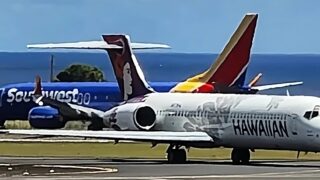

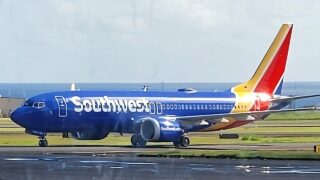
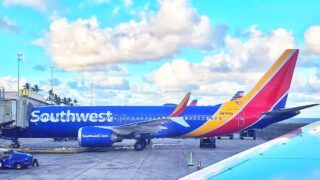
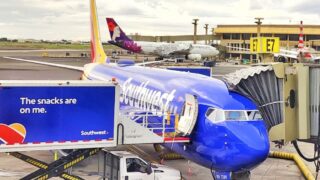
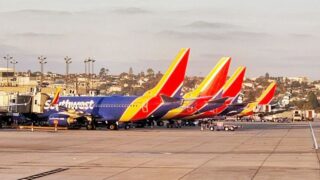
I don’t know if anyone else has noticed it, but in the bottom right-hand corner of the “shark” photo is a stalk of bird of paradise, which, as many of you know, was a prominent element of Aloha’s logos over the years. It is almost as if the ghost of Aloha Airlines is looming under the surface of the current interisland air service malaise that is the subject of this post and discussion, just maybe with some historical lessons that might come to bear….
Easy answer. Keep the government out of it.
Charge more money for flights. People will pay, the price.
High prices will cut down amount of flights available, but at least swa will make it profitable. Double the ticket price if needed.
Sea glider ! Are u kidding me ..That’s the open ocean between the islands not some fresh water lake .. You wanna be skimming the water with 15ft waves , at the mercy of high winds and bad weather .. Sea vessels to avoid not to mention marine life that could be threatened.. No thanks I’ll fly at 20k ft above the waves and the weather at 400kts reaching my destination in half the time ..
Some areas overlooked _
You are not factoring connecting passengers – whether more limited on WN, or a higher ratio on HA and as the integration moves forward, a higher percentage connecting to AS flights.
Also, as part of the consent order, you have competitors of AS who already have and will continue to have negotiated pro-rate agreements/fares for their passengers connecting beyond HNL and OGG using the current HA inter-island flights.
So, this is just not about $50 or $125 fares – you have to look at the entire picture of when/where passengers are connecting beyond Hawaii.
Freight/cargo also plays into this – more so today on HA, less so on WN.
I would not expect WN to withdraw from any of the islands. As they receive the 737 MAX 7’s, I wouldn’t be surprised if WN bases 3 or 4 of those jets on the islands – and from time-to-time, rotate them out to the mainland.
Southwest’s struggle is another reminder of how unique the situation in Hawaii is. Maybe we need more local solutions instead of relying on big mainland companies. Doesn’t look like this can turn out well.
I flew Southwest interisland again last month, and the service was great! It’s a shame to hear they’re struggling. I hope they can find a way to make it work to some degree at least. Otherwise this will be a mess.
Honestly, as much as I love cheap flights, $50 one-way tickets probably aren’t realistic given the costs. But the reality is that I’ll be traveling way less for sure at $125.
Oh No! So what happens to us, the travelers? If Southwest cuts back, are we left with only Hawaiian Airlines again? I’m worried about how much prices are going to go up.
Southwest Airlines Is the problem. By artificially undercutting prices in Hawaii so severely, they have caused Hawaiian Airlines to lose $1 Million Per Day, for years. Without the recent Alaska Airlines merger, Hawaiian would have gone bankrupt, and met the fate of Aloha Airlines. Then we’d be swimming interisland ??
Southwest went in like a shark, but maybe that’s part of the problem. Hawaii needs a different approach, not mainland-style expansion tactics. Just my two cents.
Hawaii’s unique market conditions are so tough! I can’t imagine the challenges these airlines face trying to keep fares affordable while staying profitable. And, in the end, we’re all waiting for the price shoe to drop.
I’ve been following Southwest’s expansion into Hawaii, and it’s disappointing to see them struggling. It makes me wonder if it’s really possible for any mainland airline to compete here long-term.
There’s tons of competition already for Hawaiian Airlines: Delta, American, United, etc. etc. Mainland predator airlines, artificially undercutting the real cost of business, are the problems. That’s how “Go!” Airlines, owned by Mesa Airlines, drove Aloha Airlines out of business, into bankruptcy. Thanks to that predator Airlines (“Go!” Airlines later went out of business themselves), then Aloha Airlines didn’t exist any longer to compete interisland with Hawaiian Airlines.
All you said is true…..in addition, it seems to me SWA tying up an expensive transpac plane (737 Max) to fly an inter island flight rather than use it more productively elsewhere is a bad call, especially with the operational difficulties operating a satellite inter island operation from the mainland.
Operation margins are thin enough, there’s no room for having an unsuitable aircraft to compete with.
They’ll always be saddled with the “mainland airline that tried to undermine a local institution” moniker…..not a good marketing image here.
Cocky behavior from newcomers is never appreciated in Hawaii.